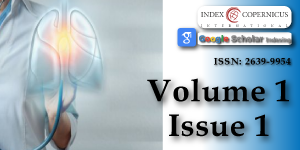Acute and chronic changes in massive Barium Sulfate aspiration in an infant who subsequently was diagnosed with severe Gastro-esophageal Reflux
Main Article Content
Abstract
The barium is often used in radiocontrast examinations of the digestive system because of mucosal absorption is limited. Massive barium aspiration is a rare complication, especially when there is no anatomic or neurological deficit. The depending on barium concentration can cause various lung effects. When the literature is reviewed, barium aspiration may be asymptomatic or lethal in massive amounts. Rarely, large amounts of barium sulphate are aspirated into the lung, there is no literature study how often this is happening.
We present a case of massive barium aspiration in this subject. The case is related to a patient’s diagnostic esophagography who complaints swallowing problems. The massive barium aspiration couldn’t notice because of the absence of acute symptoms and surgical operation of gastrointestinal tract which the patient had undergone previously. When the patient applied our Pediatric Chest Diseases Polyclinic after three months, as a result of the examinations and deep research it was understood that the case was about massive barium aspiration. The patient was directed to our center because there was a radiological appearance of bone density signs on chest X-ray. Such a complaint was not reported by the family neighter in his biography, nor was written in the epicrisis. We will share acute and chronic changes in the lungs, diagnosis and treatment approaches of this case. The infant who has ileostomy was previously operated because of necrotizing enterocolitis. And also still has severe gastro-esophageal reflux and under conservative and medical treatment, a possible fundoplication surgery is planning.
Article Details
Copyright (c) 2017 Pekcan S.

This work is licensed under a Creative Commons Attribution 4.0 International License.
Kakodkar K, Schroeder JW Jr. Pediatric dysphagia. Pediatr Clin North Am. 2013; 60: 969-977. Ref. : https://goo. gl/a2axYQ
Darrow DH, Harley CM. Evaluation of swallowing disorders in children. OtolaryngolClin North Am. 1998; 31: 405-418. Ref. : https://goo. gl/zsQsPz
Tamm I, Kortsik C. Severe barium sulfate aspiration into the lung: clinical presentation, prognosis and therapy Respiration. 1999; 66; 81-84 Ref. : https://goo. gl/FL68A3
Nishikawa M. A study of aspiration in infants with recurrent pneumonia by Barium swallow examination using different concentrations of barium. Nihon IgakuHoshasen Gakkai Zasshi. 1994; 54: 129-136. Ref. : https://goo. gl/IAjSZm
Chiu CY, Wong KS, Tsai MH. Massive aspiration of barium sulfate during an upper gastrointestinal examination in a child with dysphagia. Int J Pediatr Otorhinolaryngol. 2005; 69: 541-544. Ref. : https://goo. gl/6Usx8P
Rasley A, Logemann JA, Kahrilas PJ, Rademaker AW, Pauloski BR, et al. Prevention of barium aspiration during videofluoroscopic swallowing studies: value of change in posture. American Journal of Roentgenology. 1993; 160: 1005-1009. Ref. : https://goo. gl/7Bezkw
Lopez-Castilla J, Cano M, Munoz M, Soult JA, Andrés A, et al. Massive bronchoalveolar aspiration of barium sulphate during a radiologic study of the upper digestive tract. Pediatr Pulmonol. 1997; 24: 126-127 Ref. : https://goo. gl/R2UmJt
Nelson SP, Chen EH, Syniar GM, Christoffel KK. Prevalence of symptoms of gastroesophageal reflux during infancy. A pediatric practice-based survey. Pediatric Practice Research Group. Arch Pediatr Adolesc Med. 1997; 151: 569-572. Ref. : https://goo. gl/82Un35
Jackson M, Kapur N, Goyal V, Choo K, Sarikwal A, et al. Barium aspiration in an ınfant: a case report and review of management. Front Pediatr. 2014; 2: 37. Ref. : https://goo. gl/7tFNwS
Roggli V, Shelburne J. Mineral pneumoconiosis. 2nd ed In: Dahl DH, Hammar SP. editors. editors. Pulmonary Pathology. New York: Springer-Verlag. 1998; 589-618.
Voloudaki A, Ergazakis N, Gourtsoyiannis N. Late changes in barium sulphate aspiration: HRCT features. Eur Radiol. 2003; 13: 2226-2229. Ref. : https://goo. gl/DjEbYj
Venkatraman B, Reluman IL, Abdul-Wahab A. High resolution computed tomography appearance of late sequela of barium aspiration in an asymptomatic young child. Saudi Med J. 2005; 26: 665-710. Ref. : https://goo. gl/DKJiPS
Marchiori E, Souza A, Franquet T, Muller N. Diffuse high-attenuation pulmonary abnormalities: a pattern-oriented diagnostic approach on high-resolution CT. Am J Roentgenol. 2005; 184: 273-282. Ref. : https://goo. gl/k53l2b
Nelson S, Christofordis A, Pratt P. Barium sulfate and bismuth subcarbonate suspension as bronchographic contrast media. Radiology. 1959; 72: 829-838. Ref. : https://goo. gl/RhBSUO
Morton RE, Bonas R, Fourie B, Minford J. Videofluoroscopy in the assessment of feeding disorders of children with neurological problems. Dev Med Child Neurol. 1993; 35: 388-395. Ref. : https://goo. gl/xIv4ic
Hiorns MP, Ryan MM. Current practice in paediatric videofluoroscopy. Pediatr Radiol. 2006; 36: 911-919. Ref. : https://goo. gl/yuh9yh
Gray C, Sivaloganathan S, K. C. Simpkins. Aspiration of high-density barium contrast medium causing acute pulmonary inflammation-report of two fatal cases in elderly women with disordered swallowing. Clin Radiol. 1989; 40: 397-400 Ref. : https://goo. gl/AlqDJH

